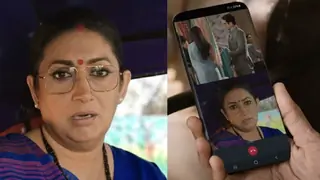Hi Friends,
I'm back again a new fictional story. This time its and issue based story in which I have used the characters of the show Arjun and some new characters to tell the narrative. The issue that I have tried to highlight here is that of female foeticide / infanticide and discrimination against a girl child which is still prevalent in India.
Female infanticide is the act of killing a female child after she is born and Female foeticide is the act of aborting a foetus because it is female even before the child is born.
This is a major social problem in India which is connected to other social evils like dowry system. In India, there is a strong bias against a girl child and girls do face discrimination in families. A son is considered to be a heir to the family where as a girl has to leave her family and bear a child for her husband's family.
There was a tendency for families to continuously produce children until a male child was born. This was primarily due to the large sexist culture that exists in India against women. This is reflected by literacy rates among women as well as economic participation, which are both particularly low in states where female foeticide is prominent and an unequal population ratio exists alongside
In earlier days, when there was no technology to determine the sex of an unborn child, in some communities, a girl child was killed immediately after she was born. Later with the development of prenatal diagnostic techniques, which were actually meant to keep a check on regular growth of foetus, these were used to determine the sex of the unborn child after which a female foetus are aborted.
India's prime minister acknowledges gendercide as a national shame, however, the police and judiciaries do not implement the law because they believe in the same thing. Authorities often let the unlawful parents and doctors off with light punishment. Often, when the mothers disobey the husband's family decision to abort the female foetus and report it to the authorities, the suits are ignored or given a light sentence: The mother is targeted for bearing girls and disobeying the family's decision to abort the child. She may even lose her job, be expose to constant death threats, and be left with unresolved cases. In addition, now also, others who give birth to girls are prone to violence. Even if she is able to give birth to the baby girls, the family is likely to not report the births and even murder them or abandon them in hospitals, temples, roadside or even municipality dustbins.
A shocking fact is that Foetal sex determination and sex-selective abortion by medical professionals has grown into a INR1,000 crore industry (US$244 million). Since 1991, 80% of districts in India have recorded an increasingly masculine sex ratio with the state of Punjab having the most masculine sex ratio. According to the decennial Indian census, the sex ratio in the 0-6 age group in India went from 104.0 males per 100 females in 1981, to 105.8 in 1991, to 107.8 in 2001, to 109.4 in 2011. The ratio is significantly higher in certain states such as Punjab and Haryana (126.1 and 122.0, as of 2001).
It is estimated that more than 10 million female foetuses have been illegally aborted in India. Researchers for the Lancet journal based in Canada and India stated that 500,000 girls were being lost annually through sex-selective abortions.
Pre-natal sex-determination was banned in India in 1994, under the Pre-conception and Prenatal Diagnostic Techniques (Prohibition of Sex Selection) Act. The act aims to prevent sex-selective abortion, which, according to the Indian Ministry of Health and Family Welfare, "has its roots in India's long history of strong patriarchal influence in all spheres of life."
It is most prominent in Gujarat and the North Indian states, which according to census data have an alarmingly low ratio of female children. Certain castes regularly practiced female infanticide and later female foeticide.
The government initially supported the practice to control population growth. The Preconception and Prenatal Diagnostic Techniques (PCPNDT) Act was passed in 1994, making sex-selective abortion illegal. It was then modified in 2003 holding medical professionals legally responsible. However, the PCPNDT Act has been poorly enforced by authorities.
This evil practice has resulted in another crime against women. It has led to an increase in human trafficking. In 2011, 15,000 Indian women were bought and sold as brides in areas where foeticide has led to a lack of women.
Though there have been many protests against this issue on smaller level and an episode based on a real incident was shown in a Crime show "Crime Patrol", this came to highlight when Famous Actor Aamir Khan chose this topic to be presented in his talk show "Satyamev Jayate" on national television. In that episode, some of the women shared their stories of how they were harrassed by their husband an in-laws for aborting a female foetus. And what came a shock was, some highly educated professionals living in metro cities too were involved in it. It broke the perception and myth among people that the abhorrent crime is prevalent among only rural people or those living in small towns or is confined only to lesser educated people.
The show claimed that according to 2011 Census, the rate at which the unborn female child is killed amounts to killing off 1,000,000 girls a year and there were 914 girls for every 1,000 boys. The episode concluded with a song "O Ri Chiraiya" sung by Swanand Kirkire along with Ram Sampath.
This song is the inspiration of this title of this story.
O Ri Chiraiya is dedicated to all those girls who did not get a chance to live in this world. This is the song from very first episode of Satyamev Jayate. In this episode Aamir Khan deals with a critical issue of female foeticide in India. O Ri Chiraiya is sung and lyrics are written by Swanand Kirkire under the music direction of talented musician Ram Sampath.
O Ri Chiraiya Song Details
Song Title: O Ri Chiraiya
Music Composer: Ram Sampath
Lyricist: Swanand Kirkire
Singer: Swanand Kirkire
Music Label: T-Series
O Ri Chiraiya
Nanhi si chidiya
Angnaa mein phir aaja re
O Ri Chiraiya
Nanhi si chidiya
Angnaa mein phir aaja re
Andhiyara hai ghana aur lahu se sana
Kirno ke tinke ambar se chunn ke
Angna mein phir aaja re
Humne tujhpe hazaro sitam hain kiye
Humne tujhpe jahaan bhar ke zulm kiye
Humne socha nahi
Tu jo ud jaayegi
Ye zameen tere bin sooni reh jaayegi
Kiske dum pe sajega angna mera
O Ri Chiraiya, meri Chiraiya
Angnaa mein phir aaja re
Tere pankho mein saare sitare jadu
Teri chunar satrangi bunu
Tere kaajal mein main kaali raina bharu
Teri mehandi mein main kacchi dhoop malu
Tere naino sajaa doon naya sapna
O Ri Chiraiya, meri Chiraiya
Angnaa mein phir aaja re
O Ri Chiraiya
Nanhi si chidiya
Angnaa mein phir aaja re
O Ri Chiraiya...
(Source of information mentioned above: Wikipedia)






































204